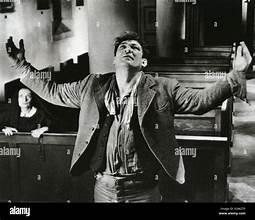A few blogs ago, I wrote about the rise of Irish-born actors currently taking Hollywood by storm: Cillian Murphy, Barry Keoghan, Paul Mescal, et. al.

With St. Patrick’s Day coming up, I decided to rent the famous 1935 film The Informer, starring Victor McLaglen and directed by John Ford. Both McLaglen and Ford won Oscars for Best Actor and Best Director; and although both of their achievements still hold up—particularly Ford’s fluid visual style, clearly inspired by the German Expressionists of the late 1920s—the film’s greatest element, its cinematography, wasn’t even nominated in its category.
In short: the more things change in Hollywood, the more they remain the same. True artistry is always ignored and/or destroyed. Just ask Orson Welles.
Anyway, I digress.
Back to my main point: Though Ford is seen as the most “American” of American filmmakers via his famous westerns, people tend to forget that Ford was equally as proud of being Irish. Born John Martin “Jack” Feeney to immigrant parents from Galway and the Aran Islands, respectively, he frequently made films with Irish or Irish American themes. Even his celebrated westerns have Irish surnamed characters and Irish humor in them.
In addition to The Informer, he also won a Best Director Oscar for 1952’s The Quiet Man with John Wayne and red-haired Maureen O’Hare, his favorite actress. Set in Ireland itself, the film is a valentine to Celtic culture (except, perhaps, for all of the fist-brawling and drinking on display). One of his own personal favorite films was 1940s The Long Voyage Home, based on playwright Eugene O’Neill’s writings about his time at sea. Apparently, even the famously reclusive and aloof O’Neill loved the film.
Toward the end of his career, Ford still had the land of Eire on his mind. He was supposed to direct 1965’s Young Cassidy, about the career of the famous Irish playwright Sean O’Casey, but fell ill two weeks into it and was replaced by another director. Ford died in 1973.
Contrast this with Frank Capra who, like Ford, was an early pioneer in American film. Both men started out in silent movies; Capra is even credited with inventing Harry Langdon’s child-man comedic persona. But in terms of ethnic pride, the path is a mile wide. Arguably just as well-known and influential as Ford, Capra rarely alluded to his Italian (Sicilian) background. The closest he came was inserting Mr. Martini into the plot of It’s A Wonderful Life.
Part of this was assimilation. Once here, Capra took to America like a duck to water. And part of this is also, perhaps, that Capra’s family fled a part of Sicily that was parched and piss-poor, an area they gratefully left behind. Whatever the reasons, what a sense of opportunity was lost.
Imagine films from the 1930s and 40s featuring biopics of, say, A.P. Giannini (founder of Bank of America) or Charles Bonaparte (founder of the FBI).
It would have been much harder for our media image to have been hijacked by mobster movies if Old Hollywood had given us a dose of dignitá.
Even “la bell’italia” would have been treated less like a shallow tourist trap. Instead, it remains the land of Mafia Mammas (2023). Pass the Brioschi!
What Ford—and also John Huston, whose last film, 1987’s The Dead, was based on James Joyce’s celebrated short story—did was lay a foundation for Irish American pride which exists until this day. St. Patrick’s Day (March 17) has officially knocked St. Joseph’s Day (March 19) off the calendar. If you doubt me, try and find a “Happy St. Joseph’s Day” card at your local Target or Walmart. Good luck! The luck o’ the Irish remains.
Victor McLaglen’s character in The Informer, Gypo, finally confesses to ratting out his friend, crying repeatedly, “I didn’t know what I was doin’!”
If only Italian American actors, writers, producers, directors would similarly come clean. It would be a first crucial step in cleaning up our media image. -BDC




Some “good” movies have been produced lately. Italian firm Iervolino and Monika Bacardi Entertainment have produced movies about Ferrari and Lamborghini for the international market.
Also, “Cabrini” came out lately. It covers racism toward Italians, a taboo for the left and Robin Di Angelo . However, these movies do not seem to do well at the box office and do not become part of the narrative.
Cabrini finished at #5 in the week-end box office results, although this media ritual is truly silly and insubstantial; basically, it is a marketing tool meant to steer viewers toward mediocrity. That is why you’ll never see a fine independent film on such a list. Hollywood cares only about money, not quality, and in squeezing the masses, not enlightening them.
I don’t expect the film to sustain that, even though, by a true miracle, the producers somehow managed to get it into 3,000 theaters, thus making it a “mainstream” movie.
Anti-Catholic and anti-Italian bigotry run too deep. Whatever edge Cabrini had was propelled by its pseudo-feminist angle. Woke viewers have probably already tuned out.
Love the Robin Di Angelo dig. Has anyone ever verified that she is Italian American? Either way, her book White Fragility is worth reading, if only to get a sense of the illogical thinking patterns of so-called progressives. Di Angelo’s book fueled what became DEI.